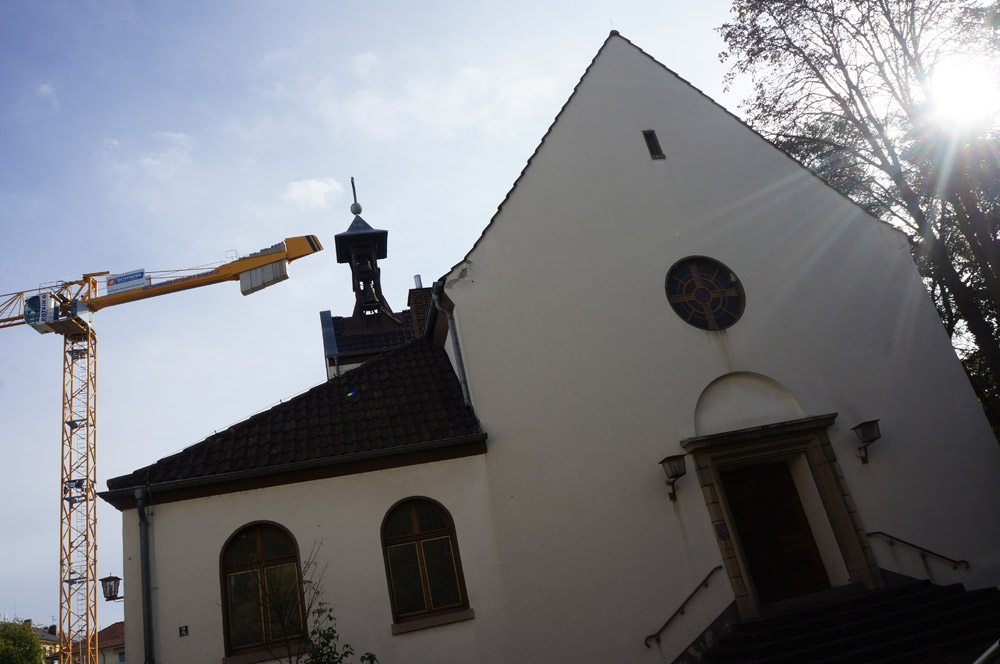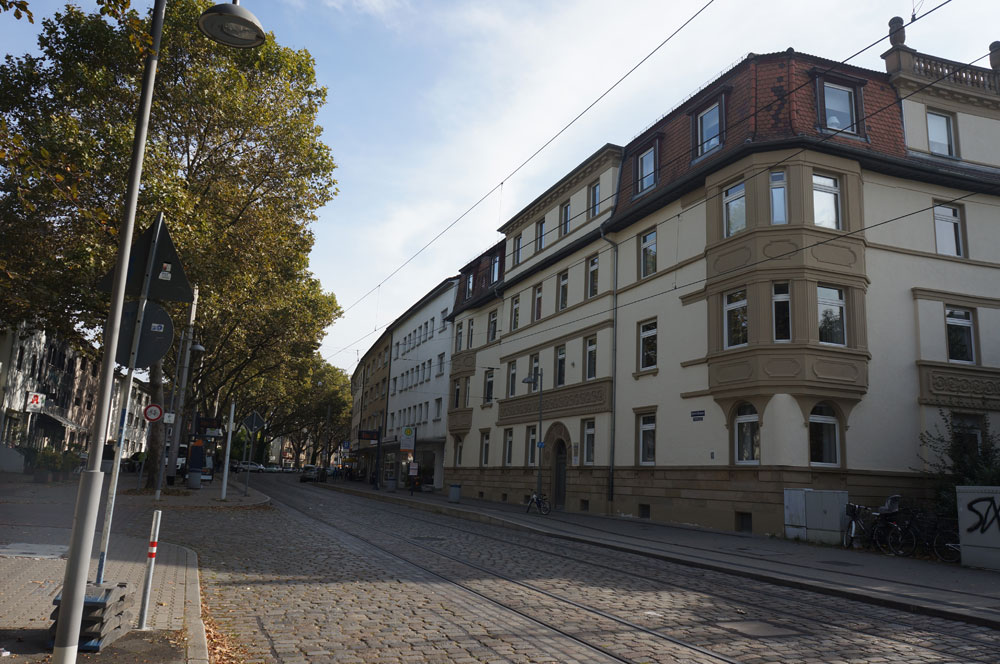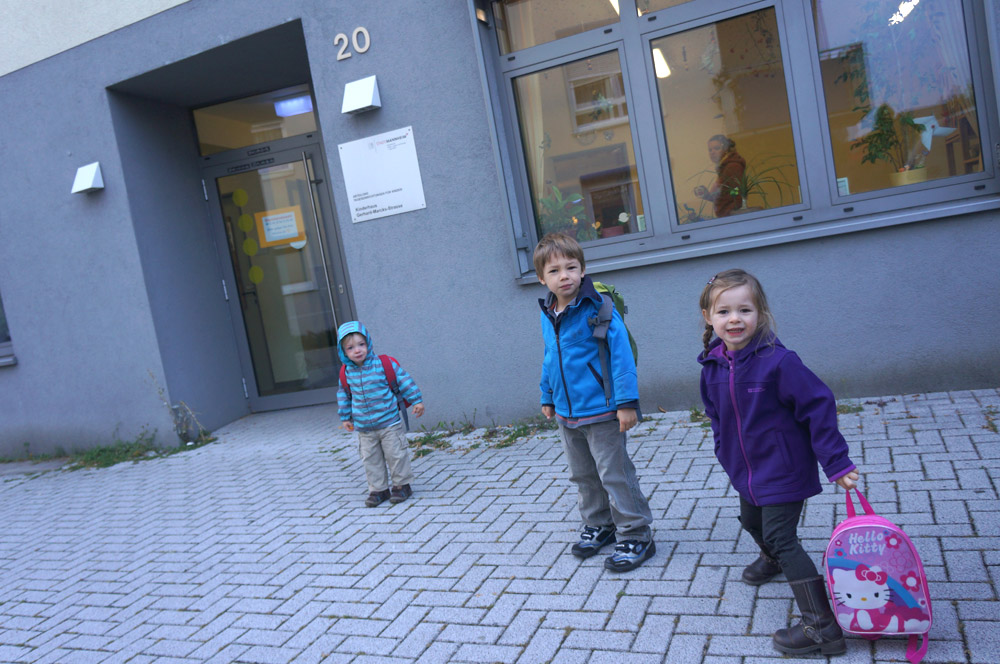Mission and the Church in a Post-Christian Context

The front entrance to the Protestant church the Stutzmans relate to, with a crane in the background. Photo courtesy of author
In Mannheim, Germany, Dave and Rebekka and their three children serve in a context where churches have experienced decline, but opportunities for mission abound.
One of the things that interested me about studying missiology was that context was something that was taken seriously. Context is integral in shaping our world view, our theological views, the nature and expression of church, and how the Gospel is transmitted and encountered. Understanding context is essential for mission.
A number of years ago while living in Germany, I attended an assembly of church leaders from the Mennonite church where the main speaker was going to give a presentation about the emerging church and to share about new expressions of Christianity in a post-Christian context.
As a way of setting the stage, the moderators prepared a skit, where they unloaded heavy bricks from a backpack, with labels on them such as “finances,” “attendance,” “young people,” all things that represented the burdens and the challenges facing our churches. They unloaded the bricks and symbolically urged us to leave our burdens and worries at the door and to not dwell on the negative or return to familiar doubts. We were to exercise a hopeful outlook.

Dave and Rebekka Stutzman with children Immanuel (left), Nathanael and Liana. Photo courtesy of author
I don’t remember much about the presentation, but afterwards the discussion at the table sticks out in my mind. Within moments of being released to talk at our tables, the conversation quickly turned skeptical and gloomy. The participants started going through each of the issues of why this and that wouldn’t work, in large part because of all the pressing matters that made ministry and church life difficult.
Furthermore, in the plenum session that followed, I discovered that our table was not alone in its pessimistic tone. I couldn’t believe it. Here we were gathered to learn about new expressions of church and how to engage a post-Christian context and all we could do was talk about our problems. I am not sure if everyone was excited about talking about the emerging church, but I am pretty sure that people didn’t realize the reflexes they were exercising.
This experience taught me a lot about the state of the church and the experience of the church in a post-Christian context. The experience of many churches has been difficult. And for many it is hard to look beyond, partly because it remains unseen. Much has been written about the state of the church in the West, of its decline, marginalization, and woeful outlook.
Yet, when I talk about mission in the Western context, I am often surprised about how the post-Christian reality doesn’t catalyze much change within the church. It is as if there is an awareness of the tremendous change going on, but it doesn’t lead to much action. Churches and leaders are certainly aware that things are changing, that things are not the same, stagnating and declining. It is obvious in the absence of young people, the overrepresentation of gray-haired people, the dwindling church budget, the steady increase in beseeching requests from denominational institutions for financial support. Yet, this has not translated into a sustained response in the way churches or denominations prioritize resources, make decisions, or shape structures.

The Stutzmans’ street and apartment building (on right). Photo courtesy of author
Much of how church is done in the West is a continuation of what was. The experience for many churches is one of yearning for better times, floundering in knowing what to do or even despairing about the future. Indeed, the experience of church in a post-Christian context is paralyzing. For me, figuring out what it means to be church means doing so within a post-Christian reality. But knowing a way forward and appropriate responses or adjustments is difficult and certainly confounding. I have found that talking about mission in a post-Christian context quickly brings forth well-practiced reflexes and assumptions. Here are a few key points of reference to consider with regard to mission and the church in a post-Christian context.
Post-Christianity is a mission field. Recognizing this context as a mission field is crucial here for me. It has the potential to be a galvanizing factor, to release leaders and to transform the church’s self-understanding as being sent into its own context. Yet, while mission comes to the fore as a concept and activity to consider anew, efforts toward bringing mission into the established church culture can easily be characterized as meeting reluctance, resistance or outright rejection. Or where there might be support, I have seen how there is a culture of carefulness, rightfully so, but it can easily be indistinguishable from a culture of restraint and aversion to risk-taking. This leaves those who are yearning for renewal and missional forms of church, to become exhausted from swimming upstream or impatient, and end up frustrated or leaving. It leads to a situation that many established churches and denominations find themselves in, in that the visionaries and risk-takers become a scarcity. If we are not willing to take risks, how can we begin to appreciate, equip and send pioneers?

Immanuel, Nathanael and Liana going to their Kindergarten. Photo courtesy of author
Mission in the post-Christian context means doing mission alongside the church. Mission in the West is in the former backyard of the church. In post-Christian Europe, mission and church converge. This is different than how many mission agencies and para-church organizations are used to thinking and operating. Mission and church planting in denominational structures still tend to be underfunded and peripheral. In fact, the binary of church structures and mission agencies of yesteryear leads to a certain ambiguity of who takes leadership and initiative. Mission structures are going to find more relevance for supporting and developing ministry in their own context. But the challenges can be complex because of that proximity. How do we encourage and release leadership that has a pioneering vision for engaging culture?
Mission in post-Christianity must navigate the tenuous relationship between rebuilding the church and creating the church anew. There is tension between placing energy and resources within the church or releasing and encouraging new initiatives. There is a tension between renewal and mission. In my experience, the pull is pretty strong toward inward, wanting to invest in renewal rather than to try new things out. So a lot of missional talk gets put into this dynamic as well. Rather than start with something completely new, effort is placed in transforming existing structures and approaches. It plays itself out in the expectations for the next generation of leaders, where the implicit desire is for them to stay and sustain what exists already. While the impulse for renewal might be present it is easily confused with the desire to want to restore what once was. How can churches learn to send and not see it as a loss? What place does mission have in a church focused on renewal?
Context matters. Taking the post-Christian context seriously is crucial. Without coming to terms with this reality, the church is left yearning for yesteryear, desiring an implicit restoration of what once was. It is paralyzing. It results in confusion of identity and vocation. It is not a church in mission. I believe the more we talk about the post-Christian context, the more church will be able to find its bearing. Knowing our context enables us for mission.
Dave serves with his wife Rebekka and three children in Mannheim, Germany, with Virginia Mennonite Missions, in partnership with Mennonite Mission Network.
